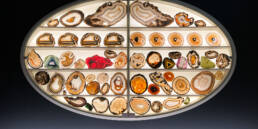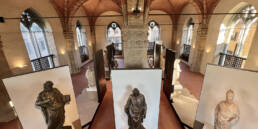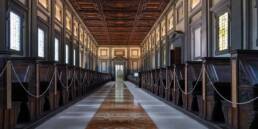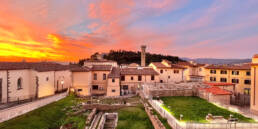This is a guest post about Piazza Santissima Annunziata and one traveler’s experience while visiting it.

I often find it difficult to visualize real places before I visit them. The names of famous cities resemble designers’ labels and the signature buildings are recognizable from postcards and films. As you continue to read about specific streets, parks and rivers you find yourself in a wonderland where names float in space without any geographical reference. What if these places only exist in a collective fantasy?
Florence, however, is one of the few places I could believe existed a long time before I would see it in real life. My fascination dates back to a course in history of architecture [that I took many years ago]. While looking for a subject for the final paper I stumbled on some aerial photographs of Renaissance squares. It seemed as if some giant had once reshaped the urban fabric, almost like someone cutting butter with a hot knife – and I had found the subject I was looking for.
The irregular forms of the medieval town were interpreted as merely chaotic by the Renaissance mind. The artist-engineers, armed with the newly developed theory of perspective set out to create new cities. They probably started with a single building and the inner court yard, turned it inside out and moved on with the concept of a city-wide design structure. A typical Renaissance square has a rectangular form and is lined with a loggia, a covered walk with columns that provides a transition between the square and the surrounding buildings.
While working on that paper I read Edmund Bacon’s “Design of Cities” and became fascinated with the Piazza Santissima Annunziata (Most Holy Annunciation) in Florence. The story begins with a minor basilica, a mother church of the Servite order dedicated to Virgin Mary, at the north side of a small piazza. The monks decided to lay out a new straight street, Via dei Servi, to connect their church with Duomo during the 13th century, and thereby started an urban process resulting later in a great expression of Renaissance ideas.
Brunelleschi, while finishing the dome over the Duomo received a commission to design the orphanage, the Ospedale degli Innocenti at the eastern side of the piazza in 1419. It would be the first building in Florence to make clear reference to classical antiquity with the façade made up of nine semicircular arches springing from columns of the Composite order.

The form of the piazza continued to remain undefined for almost a century. Michelozzo designed the central bay for the church, harmonious with Brunelleschi’s building but it was Antonio da Sangallo the Elder´s decision concerning the western façade in 1516 that finally settled the form of the piazza. Caccini’s loggia for the northern facade in 1600 finished the project started by Brunelleschi and da Sangallo.
“Any really great work has within it forces capable of influencing later development,” Edmund Bacon writes in Design of Cities. The beauty of Brunelleschi’s arcade found expression elsewhere in the piazza when Sangallo overcame his urge toward self-expression. He established the Renaissance concept of a space created by several buildings designed in relation to each other and it is really to Sangallo that we owe the present form of the piazza. According to Bacon it is often the second man who determines whether the creation of the first man will be carried forward or destroyed.
When you finally get to Florence you don’t really need a map during the first day. If you simply follow your instinct you will end up in front of the Duomo. Originally a Roman military settlement, the quadratic system derived from the two crossing streets, Cardo and Decumanum, is still recognizable. But it will soon dawn on you that beyond the regular Roman quarters Florence is essentially a medieval labyrinth.

Two decades after learning about the piazza Santissima Annuziata I came to Florence. After having reached the Duomo I consulted the map and found Via dei Servi. As I walked along the street I saw the piazza slowly unfold in front of my eyes and experienced a surreal déjà vu in a place I had never been to before.
I kept returning almost every day after the art course that I was taking a few blocks away — my reason for being in town — to find new cuddling lovers, priests mixing with beggars, UNICEF employees leaving their office housed in the former orphanage. My mind was expanding, able to absorb more useful facts. I learnt that the unique ceramic medallions featuring babies were designed by Andrea della Robbia and that the abandoned children at the Innocenti were given a last name: Innocenti. Apparently many Florentine families by that name or its variation, Noccenti, can trace their roots back to this very building but not any further.
There were also some practical things to learn, too. A mother taught her tiny child in pink to drink from one of the fountains – a useful piece of information for me as well, thirsty as I was and a stranger in town. Later a couple engaged in an Italian style argument that ended with the man throwing the back pack at the feet of his girl-friend. He started for Duomo and never returned. Another simple lesson in one of the most difficult of subjects: the fragility of romantic relationships.
By the end of my stay a few complete strangers had turned to friends. I had learned a lot about portraits and the importance of passing on knowledge with love. But I still feared that everything worth doing in art had already been done.
During one of the last evenings, exploring yet another area of the urban labyrinth I found one more art gallery – and saw a painting made by a modern artist mastering the traditional techniques. This one took my breath away. I suddenly felt convinced that there must be more art left to be painted. I reached for my notebook but let my hand fall. I would always remember. The first name was easy and the family name unforgettable. The artist’s great grand-father was one of the children left to the orphanage by Piazza Santissima Annunziata.

About the author: Mari Punakivi, a Finn, 40, graduated from Helsinki University of Technology (architecture and land surveying), and is currently working in Stockholm, Sweden as a consultant in land use planning. She is also a part time art student who spends her free time reading and travelling.
Sign up to receive future blog posts by email
Related Posts
January 30, 2024
Florence Museum News 2024
January 5, 2024
The Architecture of Michelangelo’s Laurentian Library
July 19, 2023




